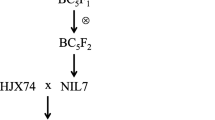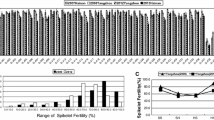Abstract
Key message
We identified and fine-mapped S58, a selfish genetic locus from Asian rice that confers hybrid male sterility in crosses between Asian and African cultivated rice, and found a natural neutral allele in Asian rice lines that will be useful for overcoming S58-mediated hybrid sterility.
Abstract
Hybrids between Asian cultivated rice (Oryza sativa L.) and African cultivated rice (Oryza glaberrima Steud) display severe hybrid sterility (HS), hindering the utilization of strong heterosis in hybrids between these species. Several African rice selfish loci causing HS in Asian–African cultivated rice hybrids have been identified, but few such Asian rice selfish loci have been found. In this study, we identified an Asian rice selfish locus, S58, which causes hybrid male sterility (HMS) in hybrids between the Asian rice variety 02428 and the African rice line CG14. Genetic analysis confirmed that S58 causes a transmission advantage for the Asian rice S58 allele in the hybrid offspring. Genetic mapping with near-isogenic lines and DNA markers delimited S58 to 186 kb and 131 kb regions of chromosome 1 in 02428 and CG14, respectively, and revealed complex genomic structural variation over these mapped regions. Gene annotation analysis and expression profiling analyses identified eight anther-expressed candidate genes potentially responsible for S58-mediated HMS. Comparative genomic analysis determined that some Asian cultivated rice varieties harbor a 140 kb fragment deletion in this region. Hybrid compatibility analysis showed that this large deletion allele in some Asian cultivated rice varieties can serve as a natural neutral allele, S58-n, that can overcome S58-mediated interspecific HMS. Our study demonstrates that this selfish genetic element from Asian rice is important for HMS between Asian and African cultivated rice, broadening our understanding of interspecific HS. This study also provides an effective strategy for overcoming HS in future interspecific rice breeding.




Similar content being viewed by others
Data availability
Data supporting the findings of this work are available within the paper and its Supplementary Information files.
References
Chen J, Ding J, Ouyang Y, Du H, Yang J, Cheng K, Zhao J, Qiu S, Zhang X, Yao J, Liu K, Wang L, Xu C, Li X, Xue Y, Xia M, Ji Q, Lu J, Xu M, Zhang Q (2008) Triallelic system of S5 is a major regulator of the reproductive barrier and compatibility of indica-japonica hybrids in rice. Proc Natl Acad Sci USA 105:11436–11441. https://doi.org/10.1073/pnas.0804761105
Chen R, Deng Y, Ding Y, Guo J, Qiu J, Wang B, Wang C, Xie Y, Zhang Z, Chen J, Chen L, Chu C, He G, He Z, Huang X, Xing Y, Yang S, Xie D, Liu Y, Li J (2022) Rice functional genomics: decades’ efforts and roads ahead. Sci China Life Sci 65:33–92. https://doi.org/10.1007/s11427-021-2024-0
Garavito A, Guyot R, Lozano J, Gavory F, Samain S, Panaud O, Tohme J, Ghesquière A, Lorieux M (2010) A genetic model for the female sterility barrier between Asian and African cultivated rice species. Genetics 185:1425–1440. https://doi.org/10.1534/genetics.110.116772
Guo J, Xu X, Li W, Zhu W, Zhu H, Liu Z, Luan X, Dai Z, Liu G, Zhang Z, Zeng R, Tang G, Fu X, Wang S, Zhang G (2016) Overcoming inter-subspecific hybrid sterility in rice by developing indica-compatible japonica lines. Sci Rep 6:26878. https://doi.org/10.1038/srep26878
Hou J, Cao C, Ruan Y, Deng Y, Liu Y, Zhang K, Tan L, Zhu Z, Cai H, Liu F, Sun H, Gu P, Sun C, Fu Y (2019) ESA1 is involved in embryo sac abortion in interspecific hybrid progeny of rice. Plant Physiol 180:356–366. https://doi.org/10.1104/pp.18.01374
Ichitani K, Toyomoto D, Uemura M, Monda K, Ichikawa M, Henry R, Sato T, Taura S, Ishikawa R (2022) New hybrid spikelet sterility gene found in interspecific cross between Oryza sativa and O. meridionalis. Plants (Basel) 11:378. https://doi.org/10.3390/plants11030378
Koide Y, Ogino A, Yoshikawa T, Kitashima Y, Saito N, Kanaoka Y, Onishi K, Yoshitake Y, Tsukiyama T, Saito H, Teraishi M, Yamagata Y, Uemura A, Takagi H, Hayashi Y, Abe T, Fukuta Y, Okumoto Y, Kanazawa A (2018) Lineage-specific gene acquisition or loss is involved in interspecific hybrid sterility in rice. Proc Natl Acad Sci USA 115:E1955–E1962. https://doi.org/10.1073/pnas.1711656115
Kubo T, Takashi T, Ashikari M, Yoshimura A, Kurata N (2016) Two tightly linked genes at the hsa1 locus cause both F1 and F2 hybrid sterility in rice. Mol Plant 9:221–232. https://doi.org/10.1016/j.molp.2015.09.014
Linares O (2002) African rice (Oryza glaberrima): history and future potential. Proc Natl Acad Sci USA 99:16360–16365. https://doi.org/10.1073/pnas.252604599
Long Y, Zhao L, Niu B, Su J, Wu H, Chen Y, Zhang Q, Guo J, Zhuang C, Mei M, Xia J, Wang L, Wu H, Liu YG (2008) Hybrid male sterility in rice controlled by interaction between divergent alleles of two adjacent genes. Proc Natl Acad Sci USA 105:18871–18876. https://doi.org/10.1073/pnas.0810108105
Ma G, Yuan LP (2015) Hybrid rice achievements, development and prospect in China. J Integr Agr 14:197–205. https://doi.org/10.1016/S2095-3119(14)60922-9
Mi J, Li G, Huang J, Yu H, Zhou F, Zhang Q, Ouyang Y, Mou T (2016) Stacking S5-n and f5-n to overcome sterility in indica-japonica hybrid rice. Theor Appl Genet 129:563–575. https://doi.org/10.1007/s00122-015-2648-0
Mizuta Y, Harushima Y, Kurata N (2010) Rice pollen hybrid incompatibility caused by reciprocal gene loss of duplicated genes. Proc Natl Acad Sci USA 107:20417–20422. https://doi.org/10.1073/pnas.1003124107
Nguyen GN, Yamagata Y, Shigematsu Y, Watanabe M, Miyazaki Y, Doi K, Tashiro K, Kuhara S, Kanamori H, Wu J, Matsumoto T, Yasui H, Yoshimura A (2017) Duplication and loss of function of genes encoding RNA polymerase III subunit C4 causes hybrid incompatibility in rice. G3 7:2565–2575. https://doi.org/10.1534/g3.117.043943
Ouyang Y, Chen J, Ding J, Zhang Q (2009) Advances in the understanding of inter-subspecific hybrid sterility and wide-compatibility in rice. Chin Sci Bull 54:2332–2341. https://doi.org/10.1007/s11434-009-0371-4
Ouyang Y, Liu YG, Zhang Q (2010) Hybrid sterility in plant: stories from rice. Curr Opin Plant Biol 13:186–192. https://doi.org/10.1016/j.pbi.2010.01.002
Qin P, Lu H, Du H, Wang H, Chen W, Chen Z, He Q, Ou S, Zhang H, Li X, Li X, Li Y, Liao Y, Gao Q, Tu B, Yuan H, Ma B, Wang Y, Qian Y, Fan S, Li W, Wang J, He M, Yin J, Li T, Jiang N, Chen X, Liang C, Li S (2021) Pan-genome analysis of 33 genetically diverse rice accessions reveals hidden genomic variations. Cell 184:3542–3558. https://doi.org/10.1016/j.cell.2021.04.046
Rogers SO, Bendich AJ (1985) Extraction of DNA from milligram amounts of fresh, herbarium and mummified plant tissues. Plant Mol Biol 5:69–76. https://doi.org/10.1007/BF00020088
Shen R, Wang L, Liu X, Wu J, Jin W, Zhao X, Xie X, Zhu Q, Tang H, Li Q, Chen L, Liu Y (2017) Genomic structural variation-mediated allelic suppression causes hybrid male sterility in rice. Nat Commun 8:1310. https://doi.org/10.1038/s41467-017-01400-y
Wang GW, He YQ, Xu CG, Zhang Q (2006) Fine mapping of f5-Du, a gene conferring wide-compatibility for pollen fertility in inter-subspecific hybrids of rice (Oryza sativa L.). Theor Appl Genet 112:382–387. https://doi.org/10.1007/s00122-005-0141-x
Wang J, Jian A, Wan H, Lei D, Zhou J, Zhu S, Ren Y, Lin Q, Lei C, Wang J, Zhao Z, Guo X, Zhang X, Cheng Z, Tao D, Jiang L, Zhao Z, Wan J (2022) Genetic characterization and fine mapping of qHMS4 responsible for pollen sterility in hybrids between Oryza sativa L. and Oryza glaberrima Steud. Mol Breeding 42:47. https://doi.org/10.1007/s11032-022-01306-8
Xie Y, Niu B, Long Y, Li G, Tang J, Zhang Y, Ren D, Liu YG, Chen L (2017a) Suppression or knockout of SaF/SaM overcomes the Sa-mediated hybrid male sterility in rice. J Integr Plant Biol 59:669–679. https://doi.org/10.1111/jipb.12564
Xie Y, Xu P, Huang J, Ma S, Xie X, Tao D, Chen L, Liu YG (2017b) Interspecific hybrid sterility in rice is mediated by OgTPR1 at the S1 locus encoding a peptidase-like protein. Mol Plant 10:1137–1140. https://doi.org/10.1016/j.molp.2017.05.005
Xie Y, Zhang Y, Han J, Luo J, Li G, Huang J, Wu H, Tian Q, Zhu Q, Chen Y, Kawano Y, Liu Y-G, Chen L (2018) The intronic cis-element SE1 recruits trans-acting repressor complexes to repress the expression of ELONGATED UPPERMOST INTERNODE1 in rice. Mol Plant 11:720–735. https://doi.org/10.1016/j.molp.2018.03.001
Xie Y, Shen R, Chen L, Liu Y (2019a) Molecular mechanisms of hybrid sterility in rice. Sci China Life Sci 62:737–743. https://doi.org/10.1007/s11427-019-9531-7
Xie Y, Tang J, Xie X, Li X, Huang J, Fei Y, Han J, Chen S, Tang H, Zhao X, Tao D, Xu P, Liu Y, Chen L (2019b) An asymmetric allelic interaction drives allele transmission bias in interspecific rice hybrids. Nat Commun 10:2501. https://doi.org/10.1038/s41467-019-10488-3
Xu P, Zhou J, Li J, Hu F, Deng X, Feng S, Ren G, Zhang Z, Deng W, Tao D (2014) Mapping three new interspecific hybrid sterile loci between Oryza sativa and O. glaberrima. Breeding Sci 63:476–482. https://doi.org/10.1270/jsbbs.63.476
Yamagata Y, Yamamoto E, Aya K, Win KT, Doi K, Sobrizal IT, Kanamori H, Wu J, Matsumoto T, Matsuoka M, Ashikari M, Yoshimura A (2010) Mitochondrial gene in the nuclear genome induces reproductive barrier in rice. Proc Natl Acad Sci USA 107:1494–1499. https://doi.org/10.1073/pnas.0908283107
Yang J, Zhao X, Cheng K, Du H, Ouyang Y, Chen J, Qiu S, Huang J, Jiang Y, Jiang L, Ding J, Wang J, Xu C, Li X, Zhang Q (2012) A killer-protector system regulates both hybrid sterility and segregation distortion in rice. Science 337:1336–1340. https://doi.org/10.1126/science.1223702
Yu Y, Zhao Z, Shi Y, Tian H, Liu L, Bian X, Xu Y, Zheng X, Gan L, Shen Y, Wang C, Yu X, Wang C, Zhang X, Guo X, Wang J, Ikehashi H, Jiang L, Wan J (2016) Hybrid sterility in rice (Oryza sativa L.) involves the tetratricopeptide repeat domain containing protein. Genetics 203:1439–1451. https://doi.org/10.1534/genetics.115.183848
Yu X, Zhao Z, Zheng X, Zhou J, Kong W, Wang P, Bai W, Zheng H, Zhang H, Li J, Liu J, Wang Q, Zhang L, Liu K, Yu Y, Guo X, Wang J, Lin Q, Wu F, Ren Y, Zhu S, Zhang X, Cheng Z, Lei C, Liu S, Liu X, Tian Y, Jiang L, Ge S, Wu C, Tao D, Wang H, Wan J (2018) A selfish genetic element confers non-Mendelian inheritance in rice. Science 360:1130–1132. https://doi.org/10.1126/science.aar4279
Yuan LP (2014) Development of hybrid rice to ensure food security. Rice Sci 21:1–2. https://doi.org/10.1016/S1672-6308(13)60167-5
Zhao Z, Zhang Z, Ding Z, Meng H, Shen R, Tang H, Liu Y-G, Chen L (2020) Public-transcriptome-database-assisted selection and validation of reliable reference genes for qRT-PCR in rice. Sci China Life Sci 63:92–101. https://doi.org/10.1007/s11427-019-1553-5
Zin Mar M, Koide Y, Ogata M, Kuniyoshi D, Tokuyama Y, Hikichi K, Obara M, Kishima Y (2021) Genetic mapping of the gamete eliminator locus, S2, causing hybrid sterility and transmission ratio distortion found between Oryza sativa and Oryza glaberrima cross combination. Agriculture 11:268. https://doi.org/10.3390/agriculture11030268
Acknowledgements
The authors would like to thank our laboratory coworkers for assistance with help growing plant materials and surveys of pollen fertility.
Funding
This research was supported by grants from the National Nature Science Foundation of China (32270671 and 31991222), the Double First-class Discipline Promotion Project (2021B10564001), and the Guangdong Natural Science Funds for Distinguished Young Scholars (2021B1515020089).
Author information
Authors and Affiliations
Contributions
YX and YF designed all experiments and analyzed the data; YF, JT and RL performed most of the experimental work; YX wrote the manuscript. YL and LC provided constructive advice regarding the experiments and manuscript preparation.
Corresponding author
Ethics declarations
Conflict of interest
The authors declare that they have no conflict of interest.
Additional information
Communicated by Diane E. Mather.
Publisher's Note
Springer Nature remains neutral with regard to jurisdictional claims in published maps and institutional affiliations.
Supplementary Information
Below is the link to the electronic supplementary material.
Rights and permissions
Springer Nature or its licensor (e.g. a society or other partner) holds exclusive rights to this article under a publishing agreement with the author(s) or other rightsholder(s); author self-archiving of the accepted manuscript version of this article is solely governed by the terms of such publishing agreement and applicable law.
About this article
Cite this article
Feng, Y., Tang, J., Liu, R. et al. Characterization and fine-mapping of a new Asian rice selfish genetic locus S58 in Asian–African rice hybrids. Theor Appl Genet 136, 87 (2023). https://doi.org/10.1007/s00122-023-04348-4
Received:
Accepted:
Published:
DOI: https://doi.org/10.1007/s00122-023-04348-4




